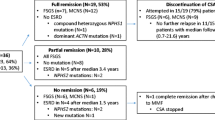Abstract
Background
Cyclosporine (CsA) was found to be efficient in decreasing proteinuria in both steroid-dependent and steroid-resistant nephrotic patients. We aimed to explore the potential long-term benefits and hazards of CsA and their predictors among a large group of nephrotic patients.
Methods
In this retrospective analysis, we included 197 pediatric patients with idiopathic nephrotic syndrome (INS) of whom 103 were steroid dependent and 94 steroid resistant.
Results
CsA induced complete remission in 132 (67%) and partial response in 13 (6.6%). Cyclosporine was received for a period of 22.16 ± 12.21 months. Univariate analysis showed that the response to CsA was significantly better in steroid-dependent children, in minimal change disease (MCD), diffuse mesangial proliferative glomerulonephritis (DMP) and focal segmental glomerulosclerosis (FSGS) than in other pathological lesions and in those who had lower quantities of pretreatment proteinuria. Only the prior response to steroids and concomitant use of ketoconazole with CsA were valid predictors for better response to CsA with multivariate analysis. Discontinuation of the drug in 40 patients resulted in relapse in 26 patients while the remaining 14 patients maintained remission. Renal dysfunction developed in 18 patients of whom 12 recovered completely on drug discontinuation. Thirty-seven patients developed hypertension. Multivariate analysis showed that all side-effects were significantly more prevalent in CsA-resistant patients.
Conclusion
CsA is effective and well tolerated in the long-term treatment of INS in children, however two thirds of cases showed relapse after CsA discontinuation
Similar content being viewed by others
References
Ponticelli C, Passerini P (1994) Treatment of the nephrotic syndrome associated with primary glomerulonephritis. Kidney Int 46(3):595–604
Ponticelli C, Edefonti A, Ghio L, Rizzoni G, Rinaldi S, Gusmano R, Lama G, Zacchello G, Confalonieri␣R, Altieri P (1993) Cyclosporine versus cyclophosphamide for patients with steroid-dependent and frequency relapsing nephrotic syndrome: a multi center randomized controlled trial. Nephrol Dial Transplant 8(12):1326–1332
Niaudet P, Habib R (1994) Cyclosporine in the treatment of idiopathic nephrosis. J Am Soc Nephrol 5(4):1049–1056
Niaudet P (1999) Steroid-resistant idiopathic nephrotic syndrome. In T Martin Barratt, Ellis DA, William E (eds) Pediatric Nephrology 4th edn., Lippin Cott Willams & Wilkins, A wolters Kluwer Company 46: 749–759
Hulton SA, Neuhaus TJ, Dillon MJ, Barratt TM (1994) Long-term cyclosporine A treatment of minimal-change nephrotic syndrome of childhood. Pediatr Nephrol 8(4):401–403
Burgess E (1999) Management of focal segmental glomerulosclerosis: evidence-base recommendation. Kidney Int 70: S26–s32
Meyrier A. (1999) Treatment of primary focal segmental glomerulosclerosis. Nephrol Dial Trans plant 14(S3):74–78
Catran DC, Appel GB, Hebert LA, Hunsicker LG,␣Pohl MA, Hoy WE, Maxwell DR, Kunis CL (2001) North American Nephrotic Syndrome Study Group. Cyclosporine in patients with steroid resistant membranous nephropathy: a randomized trial. Kidney Int 59(4):1484–1490
Meyrier A, Niaudet P, Brodehl J (1992) Optimal use of Sandimmun in nephrotic syndrome. Springer-Verlag Berlin Heidelberg P1
Ittel TH, Clasen W, Fuhs M, Kindler J, Mihatch MJ, Sieberth HG (1995) Long-term cyclosporine A therapy in adults with minimal change nephrotic or focal glomerulosclerosis. Clin Nephrol 44(3):156–162
Noyan A, Anarat A, Tuncer I, Gönlüsen G, Polat S. (1995) Efficacy and side effects of cyclosporine A in nephrotic syndrome of childhood. Nephron 70(4): 410–415
Broyer M, Meyrier A, Niaudet P, Habib R (1998) Minimal changes and focal segmental glomerular sclerosis. In Davison AM, Cameron JS, Grumfeld JP, Kerr DNS, Ritz E, Winearls CG (eds) Oxford textbook of clinical nephrology. 2nd edn. Oxford University Press, Oxford pp 422–535
Brandis M, Burghard R, Leititis J, Zimmerhackl B, Hildebrand F, Helmchen U (1988) Cyclosporine A for treatment of nephrotic syndrome. Transplant Proc 20 (3 S4):275–279
Tejani AT, Butt K, Trachtman H, Suthanthiran M, Rosenthal CJ, Khawar MR (1988) Cyclosporine A induced remission of relapsing nephrotic syndrome in children. Kidney Int 33(3):729–734
Meyrier A, Noel LH, Auriche P, Callard P. (1994) Long-term renal tolerance of cyclosporine A treatment in adult INS. Collaborative study group of the societe de Nephrologie. Kidney Int 45(5):1446–1456
Catran DC, Appel GB, Hebert LA, Hunsicker LG, Pohl MA, Hoy WE, Maxwell DR, Kunis CL. (1999) A randomized trial of cyclosporine in patients with steroid resistant focal segmental glomerulosclerosis. North America nephrotic syndrome study group. Kidney Int 56(6):2220–2226
Singh A, Tejani C, Tejani A. (1999) One-center experience with cyclosporine in refractory nephrotic syndrome in children. Pediatr Nephrol 13 (1):26–32
Gilbert SC, Emmett M, Menter A, Silverman A, Klintmalm G (1989) Cyclosporine therapy for psoriasis: serum creatinine measurements are unreliable predictor of decreased renal function. J␣Am Acad Derm 21: 470–474
Iijiama K, Hamahira K, Tanaka R, Kobayashi A, Nozu K, Nakamura H, Yoshikawa N. (2002) Risk factors for cyclosporine induced tubulointerstitial lesions in children with minimal change nephrotic syndrome. Kidney Int 61(5):1801–1805
Author information
Authors and Affiliations
Corresponding author
Rights and permissions
About this article
Cite this article
Sheashaa, H., Mahmoud, I., El-Basuony, F. et al. Does cyclosporine achieve a real advantage for treatment of idiopathic nephrotic syndrome in children? A long-term efficacy and safety study. Int Urol Nephrol 39, 923–928 (2007). https://doi.org/10.1007/s11255-007-9194-x
Accepted:
Published:
Issue Date:
DOI: https://doi.org/10.1007/s11255-007-9194-x




